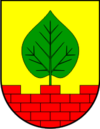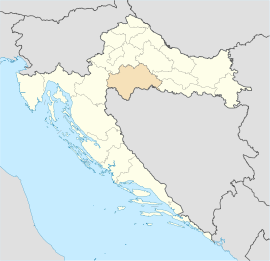Lipovljani
| Lipovljani | ||
|
||
|
|
||
| Basic data | ||
|---|---|---|
| State : |
|
|
| County : |
|
|
| Area : | 114.4 km² | |
| Residents : | 3,455 (2011) | |
| Population density : | 30 inhabitants per km² | |
| Telephone code : | (+385) 044 | |
| Postal code : | 44322 | |
| License plate : | KT | |
| Structure and administration (as of 2017) |
||
| Community type : | city | |
| Mayor : | Mario Ribar ( HSS ) | |
| Website : | ||
Lipovljani is a city and a municipality ("općina") in Croatia . It has 3,455 inhabitants (as of 2011) and is located in the Sisak-Moslavina County , approx. 90 km southeast of the Croatian capital Zagreb .
geography
Lipovljani is located in the far east of the Sisak-Moslavina County . The community belongs to the (historical) region of West Slavonia and is approx. 20 km from the Croatian-Bosnian-Herzegovinian border .
Ethnic composition
According to the 2011 census in Croatia, Croatians make up the ethnic majority in Lipovljani (87.47%). Minorities worth mentioning in Lipovljani are the ethnic groups of the Ukrainians (4.28%), the Slovaks (3.07%) and the Czechs (2.55%). A small number of other ethnic groups also live in Lipovljani (including the Magyars , Italians , Serbs ), who make up a total of 2.40% of the community's population.
history
In the 19th century and until the end of the First World War in 1918, Lipovljani was part of the Kingdom of Croatia-Slavonia within the Požega ( Poschegg ) county .
At the time of World War II were from the Croatian fascist Ustasha 177 inhabitants of the Lipovljani Jasenovac concentration camp , about 15 km away, abducted and murdered.
The area of the municipality of Lipovljani was bombed and attacked by the Yugoslav People's Army (JNA) and Serbian irregular groups during the Croatian War. There were air strikes, heavy exchanges of grenades and gunfire, and rocket attacks that led to personal and material damage. The municipality of Lipovljani was not taken by the JNA during the Yugoslav wars.
During the war and afterwards (from 1991 to 2000) around 3,000 refugees from West Slavonia , the Pounja (the area around Hrvatska Kostajnica ) and Bosnia and Herzegovina were also housed in Lipovljani .
The municipality of Lipovljani as such was founded in 1993 as part of a territorial reform of the two-year-old Republic of Croatia with its current expansion. The places Kraljeva Velika , Krivaj , Lipovljani and Piljenice were part of the Novska municipality before the Lipovljani municipality was founded .
Congregation Day is celebrated on March 19th.
Transport and infrastructure
Lipovljani is on the A3 Autocesta , which runs from Zagreb via Slavonski Brod to the Croatian-Serbian border to Lipovac . The Lipovljani junction is located southwest of the city center.
With the Lipovljani stop, the city is connected to the Dugo Selo – Vinkovci railway line . HŽ trains run daily from Zagreb to Novska / Vinkovci , which also stop in Lipovljani.
Personalities
- Josip Kozarac (1858–1906), author, lived in Lipovljani
- Nina Kraljić (1992), singer, was born in Lipovljani
Individual evidence
- ↑ Population sorted by age, gender and settlement in the Lipovljani municipality. December 2012, accessed on July 17, 2017 .
- ↑ Departure and arrival boards of Deutsche Bahn for Lipovljani. Retrieved July 17, 2017 .

